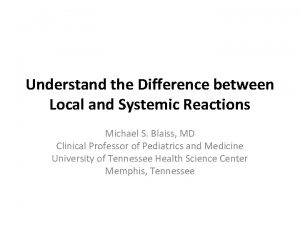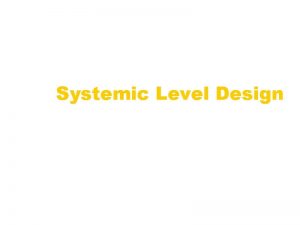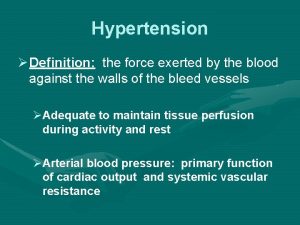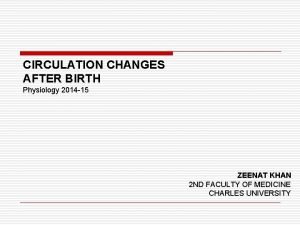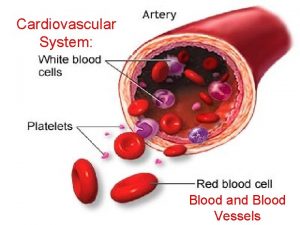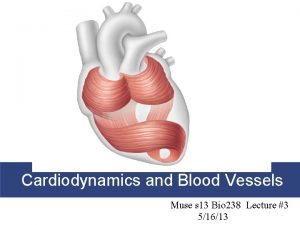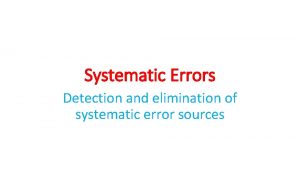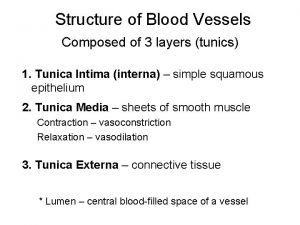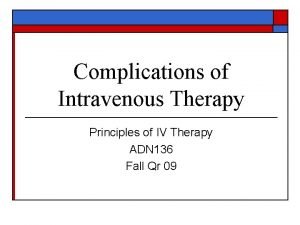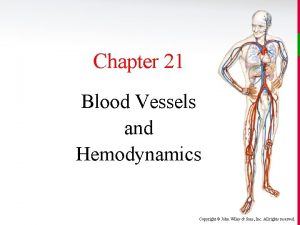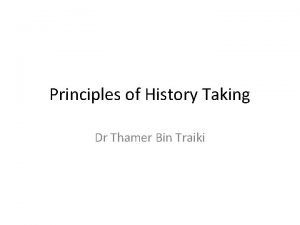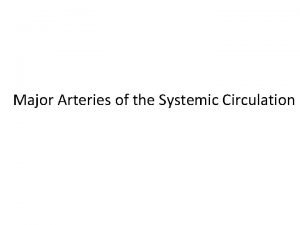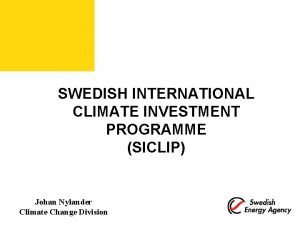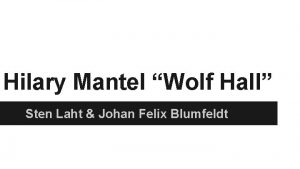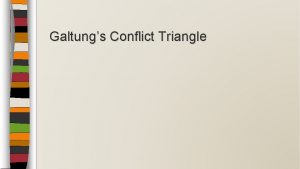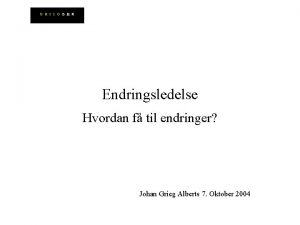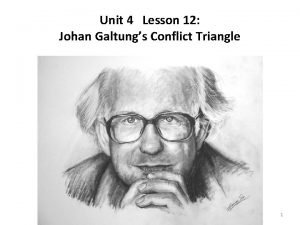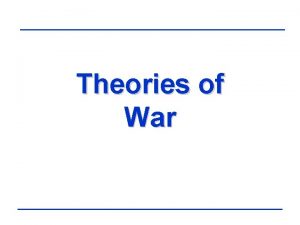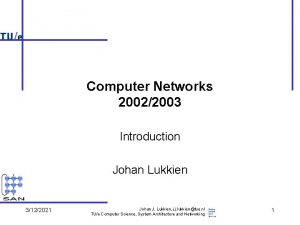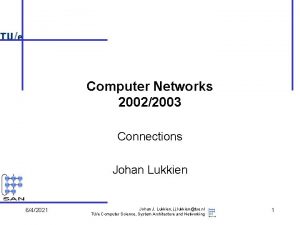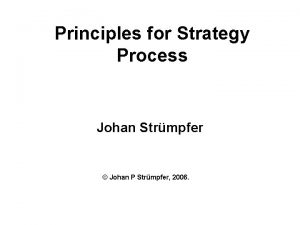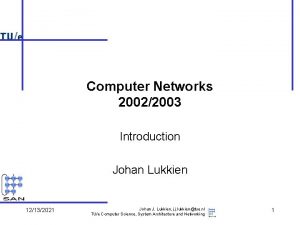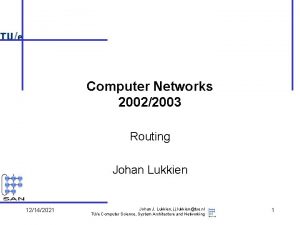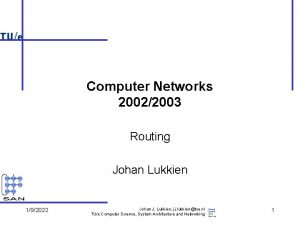Theories of General War Systemic MacroTheories Johan M





























































































- Slides: 93

Theories of (General) War Systemic & Macro-Theories Johan M. G. van der Dennen

Raiding (dawn attack) by a Florida Indian tribe (de Bry, ± 1590)

The phalanx: the major invention of ‘civilized’ warfare

Theories of (General) War • LEVELS of ANALYSIS (Waltz):

Theories of (General) War • LEVELS of ANALYSIS (Waltz): • MAN

Theories of (General) War • LEVELS of ANALYSIS (Waltz): • MAN • The STATE

Theories of (General) War • LEVELS of ANALYSIS (Waltz): • MAN • The STATE • The International SYSTEM

Theories of (General) War • LEVELS of ANALYSIS (Waltz): • MAN – Intrastate processes – and characteristics • The STATE – Interstate processes – and characteristics • The International SYSTEM

Theories of (General) War • LEVELS of ANALYSIS (Waltz): • MAN • Type of government or regime • Turmoil / Revolution • Army / Arms technology • The STATE • The International SYSTEM

Theories of (General) War • LEVELS of ANALYSIS (Waltz): • MAN • Type of government or regime • Turmoil / Revolution • Army / Arms technology • The STATE – Dyadic (border disputes) – Polyadic (alliances) – Systemic (power distribution) • The International SYSTEM

Theories of (General) War • LEVELS of ANALYSIS (Waltz): • MAN • Strategic (voluntaristic) • The STATE • Cataclysmic (deterministic) • The International SYSTEM

Theories of (General) War • LEVELS of ANALYSIS (Waltz): • MAN • Strategic (voluntaristic) • The STATE • Cataclysmic (deterministic) • The International SYSTEM • (State anarchy / Security dilemma)

Theories of (General) War • WAR: IRRATIONAL? • “… the emptiness of reasons men verbalize for war suggests that war does not rest on any rationale" (Donald Wells, The War Myth, 1967)

Theories of (General) War • WAR: RATIONAL? • “The conflicts between states which have usually led to war have normally arisen, not from any irrational and emotive drives, but from almost a superabundance of analytic rationality. . . in general men have fought during the past two hundred years neither because they are aggressive nor because they are acquisitive animals, but because they are reasoning ones: because they discern, or believe that they can discern, dangers before they become immediate, the possibility of threats before they are made” (Michael Howard, The Causes of War, 1983).

Theories of (General) War • OR BOTH? • “As a total phenomenon its dominant tendencies always make war a remarkable trinity – composed of primordial violence, hatred and enmity, which are to be regarded as a blind natural force; of the play of chance and probability, within which the creative spirit is free to roam; and of its element of subordination, as an instrument of policy, which makes it subject to reason alone” (Karl von Clausewitz, On War [Vom Kriege], 1832). (Note: this kind of rationality is often called ‘bounded’ or ‘myopic’).

Theories of (General) War • The Nature of War • Much of the 'nature of war' is found not on the battlefield, but in the hostile behavior and attitudes that characterize a state's foreign policy. Q. Wright (1942) calls attention to the discussion of this psychological aspect of war in Hobbes' Leviathan, (1651) where the oscillations of war and peace are compared to the weather: “As the nature of foul weather lieth not in a shower or two of rain, but in an inclination thereto of many days together; so the nature of war consisteth not in actual fighting, but in the known disposition thereto during all the time there is no assurance to the contrary”.

Theories of (General) War • Distinction of peace and war? • Many political realists point out that the common basis of policy in both peace and war, namely the quest for power, makes them two inseparable parts of the same social activity. Blainey (1973) contends that the causes of war and peace dovetail into one another: "War and peace are not separate compartments. Peace depends on threats and force; often peace is the crystallization of past force. " Or formulated most succinctly: "In a system of power politics, there is no difference in kind between peace and war" (Schwartzenberger, 1950).

Theories of (General) War • War is a means of achieving an end, a weapon which can be used for good or for bad purposes. Some of these purposes for which war has been used have been accepted by humanity as worthwhile ends: indeed, war performs functions which are essential in any human society. It has been used to settle disputes, to uphold rights, to remedy wrongs: and these are surely functions which must be served. One may say, without exaggeration, that no more stupid, brutal, wasteful or unfair method could ever have been imagined for such purposes, but this does not alter the situation (Eagleton, 1948).

Theories of (General) War • These formulations are reminiscent of Ambrose Bierce's sardonic definition of "peace" as: "a period of cheating between two periods of fighting" (Devil's Dictionary), or Orwell's famous dictum from "1984": "Peace is War". • Diametrically opposed to the vista of peace and war as a bipolar continuum is the view of a sharp and clear‑cut borderline existing between the two conditions, thus implying a boundarytransgression in the transition from one state of affairs to the other (e. g. , Brodie, 1973).

Theories of (General) War • The most outspoken advocate, perhaps, of this view is Wells (1967), who succinctly affirms: "Notions of some limbo between war and peace are either contradictory or unintelligible". Or, as it was stated in classical times: "Inter bellum et pacem nihil medium".

Theories of (General) War • The sociopolitical definition of war • The general outlook on war as an international or inter-State phenomenon has been shared by many students, regardless of their professional background as political scientists, historians, sociologists, psychologists or military analysts. Von Clausewitz (1911) defined war as "an act of violence intended to compel our opponents to fulfil our will", and elsewhere he emphasized the continuity of violence with other political methods: "War is nothing but a continuation of political intercourse, with an admixture of other means. "

Theories of (General) War • Sorel (1912) defined war as a "political act by means of which States, unable to adjust a dispute regarding their obligations, rights or interests, resort to armed force to decide which is the stronger and may therefore impose its will on the other". • Deutsch & Senghaas (1971): "By ‘war’ we mean actual large‑scale organized violence, prepared and maintained by the compulsion and legitimacy claims of a State and its government, and directed against another State or quasi‑State, i. e. , a relatively comparable political organization".

Theories of (General) War • The judicial conception of war • Closely related to a political definition of war is the judicial conception. Q. Wright (1942; 1965) describes war as "a legal condition which equally permits two or more hostile groups to carry on a conflict by armed force". The Marqués de Olivert is quoted as declaring that "war is a litigation or suit (litigio) between nations that defend their rights, in which force is the judge and victory is the judicial award". This analogical and figurative characterization of war is perhaps more literary than factual (Bernard, 1944).

Theories of (General) War • Quantitative criteria in the definition of war • If we are to take this view that war is simply one form of political intercourse, how do we know when the line dividing nonviolent conflict from violence has been meaningfully crossed? One interesting attempt to fix the threshold quantitatively was made by Richardson (1960) who tried to arrange all "deadly quarrels" on a continuum of violent conflict, ranging from one killed (murder) to tens of millions killed (Second World War). The threshold of war was crossed when deaths went over 1000 (=103).

Theories of (General) War • Singer & Small (1972) and Deutsch & Senghaas (1973) call "war" any series of events that meets the following three criteria: – (1) Size: it results in at least 1000 battle deaths (not counting, therefore, the indirect victims through famine, lack of shelter, and disease). – (2) Preparation: it has been prepared in advance , and/or is being maintained, by large‑scale social organizations through such means as the recruitment, training and deployment of troops, the acquisition, storage and distribution of arms and ammunition, and – (3) Legitimation: it is being legitimized by an established governmental organization, so that largescale killing is viewed not as a crime but as a duty.

Theories of (General) War • Multifactoriality of war causation • War as a complex multi-dimensional social phenomenon has so many sources and causes that no theory of a single cause can explain its nature. One cannot find a single necessary condition and a single sufficient condition; one can only try to find sources, factors, conditions important for the occurrence of war. “Any theory of the causes of war in general or of any war in particular that is not inherently eclectic and comprehensive, i. e. , which does not take into account at the outset the relevance of all sorts of diverse factors, is bound for that very reason to be wrong” (Brodie, 1974).

Theories of (General) War • Typologies of war • Numerous typologies and categorizations of war have been proposed. Q. Wright (1942; 1965) has developed a typology of war which distinguishes among four categories: (1) the civil war, which takes place within the boundaries of a sovereign nation; (2) the balance of power war, in which members of a State system are at war among themselves; (3) the defensive war, which acts to guard a civilization against the intrusions of an alien culture; and (4) the imperial war, in which one civilization attempts to expand at the expense of another.

Theories of (General) War • Singer, Small and Kraft (1965), as do many other authors, follow Wright's classification in distinguishing among civil, colonial and international wars, but with a more focused emphasis in that wars between civilizations are not explicitly introduced. Midlarsky (1975) developed a classification of wars, based on a combination of the premises of rank order and scope. In addition, two variables specific to political violence are included. These are the intensity of violence in the form of the number killed, and duration, as a temporal indicator. Finally, the motivation of actors is taken into account.

Theories of (General) War • The Realist Paradigm

Theories of (General) War • The Realist Paradigm – World politics is statecentric

Theories of (General) War • The Realist Paradigm – World politics is statecentric – The world system is anarchically structured

Theories of (General) War • The Realist Paradigm – World politics is statecentric – The world system is anarchically structured – Force is the ultimate ratio of international politics

Theories of (General) War • The Realist Paradigm – World politics is statecentric – The world system is anarchically structured – Force is the ultimate ratio of international politics – The hierarchy of state interests is dominated by the search for security

Theories of (General) War • The Realist Paradigm – World politics is statecentric – The world system is anarchically structured – Force is the ultimate ratio of international politics – The hierarchy of state interests is dominated by the search for security – The primary means of security is power

Theories of (General) War • The Realist Paradigm – World politics is statecentric – The world system is anarchically structured – Force is the ultimate ratio of international politics – The hierarchy of state interests is dominated by the search for security – The primary means of security is power – Hence international politics is a struggle for power

Theories of (General) War • The Realist Paradigm – Action-reaction spiral

Theories of (General) War • The Realist Paradigm – Action-reaction spiral – The classic security dilemma

Theories of (General) War • The Realist Paradigm – Action-reaction spiral – The classic security dilemma • This explains why states that prefer peace can rationally choose to wage war

Theories of (General) War • Balance-of-Power Theories

Theories of (General) War • Balance-of-Power Theories • According to most balance-of-power theorists, power is acquired by – (1) the addition of territory;

Theories of (General) War • Balance-of-Power Theories • According to most balance-of-power theorists, power is acquired by – (1) the addition of territory; – (2) the erection of buffer states;

Theories of (General) War • Balance-of-Power Theories • According to most balance-of-power theorists, power is acquired by – (1) the addition of territory; – (2) the erection of buffer states; – (3) undermining the enemy's strength;

Theories of (General) War • Balance-of-Power Theories • According to most balance-of-power theorists, power is acquired by – (1) the addition of territory; – (2) the erection of buffer states; – (3) undermining the enemy's strength; – and most importantly (4) forming alliances

Theories of (General) War • Balance-of-Power Theories • According to most balance-of-power theorists, power is acquired by – (1) the addition of territory; – (2) the erection of buffer states; – (3) undermining the enemy's strength; – and most importantly (4) forming alliances • Balance-of-power theories do not provide a basis for believing that a balance of power leads to peace

Theories of (General) War – Blainey’s dyadic power theory

Theories of (General) War – Blainey’s dyadic power theory – Bueno de Mesquita’s expected utility theory

Theories of (General) War – Blainey’s dyadic power theory – Bueno de Mesquita’s expected utility theory – Organski’s power transition theory & variants:

Theories of (General) War – Blainey’s dyadic power theory – Bueno de Mesquita’s expected utility theory – Organski’s power transition theory & variants: • Modelski & Thompson’s long-cycle theory

Theories of (General) War – Blainey’s dyadic power theory – Bueno de Mesquita’s expected utility theory – Organski’s power transition theory & variants: • Modelski & Thompson’s long-cycle theory • Gilpin’s theory of hegemonic transitions

Theories of (General) War – Blainey’s dyadic power theory – Bueno de Mesquita’s expected utility theory – Organski’s power transition theory & variants: • Modelski & Thompson’s long-cycle theory • Gilpin’s theory of hegemonic transitions • Goldstein’s Kondratieff-waves theory

Theories of (General) War – Blainey’s dyadic power theory – Bueno de Mesquita’s expected utility theory – Organski’s power transition theory & variants: • • Modelski & Thompson’s long-cycle theory Gilpin’s theory of hegemonic transitions Goldstein’s Kondratieff-waves theory Doran’s relative power cycle theory

Theories of (General) War – Blainey’s dyadic power theory – Bueno de Mesquita’s expected utility theory – Organski’s power transition theory & variants: • • • Modelski & Thompson’s long-cycle theory Gilpin’s theory of hegemonic transitions Goldstein’s Kondratieff-waves theory Doran’s relative power cycle theory Wallerstein’s world economy theory

Theories of (General) War – Blainey’s dyadic power theory – Bueno de Mesquita’s expected utility theory – Organski’s power transition theory & variants: • • • Modelski & Thompson’s long-cycle theory Gilpin’s theory of hegemonic transitions Goldstein’s Kondratieff-waves theory Doran’s relative power cycle theory Wallerstein’s world economy theory – Galtung’s rank-disequilibrium theory

Theories of (General) War – Blainey’s dyadic power theory – Bueno de Mesquita’s expected utility theory – Organski’s power transition theory & variants: • • • Modelski & Thompson’s long-cycle theory Gilpin’s theory of hegemonic transitions Goldstein’s Kondratieff-waves theory Doran’s relative power cycle theory Wallerstein’s world economy theory – Galtung’s rank-disequilibrium theory – Choucri & North’s lateral pressure theory

Theories of (General) War • Blainey's dyadic power theory – A theory that traces the causes of war to the dyadic power relationship between two states - emphasizing the perceptions of this relationship rather than the objective balance of power - is suggested by Blainey (1973). He argues that war is a dispute about the measurement of power and that wars usually begin when two nations disagree on their relative strength, defined in terms of military power.

Theories of (General) War • Blainey's dyadic power theory – A theory that traces the causes of war to the dyadic power relationship between two states - emphasizing the perceptions of this relationship rather than the objective balance of power - is suggested by Blainey (1973). He argues that war is a dispute about the measurement of power and that wars usually begin when two nations disagree on their relative strength, defined in terms of military power. – If states could agree on the 'objective' balance of power they could predict the outcome of the war, settle their differences on the basis of compromises proportional to their shared expectations regarding the outcome of war, and therefore avoid the cost of fighting.

Theories of (General) War • Bueno de Mesquita's expected utility theory – Rational, expected-utility maximizing with respect to war and peace decisions would involve the following calculations: Leaders calculate their expected utility from a bilateral war on the basis of an evaluation of the costs and benefits of victory and defeat, each weighted by its probability of occurrence. They then calculate the additions or subtractions from their expected utility that would result from the intervention of third parties in support of their adversaries or themselves. The probabilities of victory and defeat are a linear function of the distribution of military capabilities, modified by a loss-of-strength gradient over distance.

Theories of (General) War • Organski's power transition theory – Organski (1968: vii) summarizes theory as follows: “The overall patterns of world politics in the modern era are caused by sharp differences in social, economic, and political modernization among and within nations. Differential modernization in turn causes shifts in the distribution of world power among states. It is these changes that underlie the wars and other conflicts of our era. The immensely complex patterns that create these shifts in power, the shifts themselves, and their consequences are not easily deflected by diplomacy or military power”.

Theories of (General) War • Organski's power transition theory (2) – Organski's basic argument is that the likelihood of a major war is greatest when the military power of a dissatisfied challenger begins to approach those of the leading state in the system, for the challenger will eventually initiate a war to gain benefits, privileges, and influence commensurate with its newly acquired military power. Thus the key condition for war is not the equality of capabilities per se nor the changes in those capabilities but, instead, the interaction effect between these two variables.

Theories of (General) War • Organski's power transition theory (3) – The idea that changing power differentials are a primary cause of international war, particularly major wars involving the leading states in the system, is not really new. It can be traced to Thucydides' ([431 -411 B. C. ] 1954: 1/23) argument that "what made the Peloponnesian War inevitable was the growth of Athenian power and the fear which this caused in Sparta", and scattered references to the importance of uneven rates of growth can be found in a long history of realist thinking on international politics.

Theories of (General) War • Organski's power transition theory (4) – An alternative hypothesis suggests a more plausible mechanism by which an impending power transition may lead to war: the leading state may launch a 'preventive war' in an attempt to block or retard the rise of the challenger while that opportunity is still available (Levy, 1989: 253).

Theories of (General) War – The theoretical importance of preventive war has been widely recognized by political scientists. Its historical importance has also been recognized. For Thucydides ([431 -411 B. C. ] 1954: 1/69), Sparta's primary motivation was reflected in the Corinthians' argument for war against Athens: "instead of going out to meet them, you prefer to stand still and wait till you are attacked, thus hazarding everything by fighting with opponents who have grown far stronger than they were originally". Howard (1983: Ch. 1) suggests that Thucydides' explanation for the origins of the Peloponnesian War is true for most wars: "The causes of war remain rooted, as much as they were in the pre-industrial age, in perceptions by statesmen of the growth of hostile power and the fears for the restriction, if not the extinction, of their own". Taylor (1954: 166) suggest that "every war between Great Powers [in the 1848 -1918 period]. . . started out as a preventive war".

Theories of (General) War • Modelski & Thompson's long-cycle theory – The power transition hypothesis has been incorporated into several recent theories of systemic change and hegemonic war in world politics. One is 'long-cycle theory'. which has been developed by Modelski & Thompson (1989). According to this view, there are three principal structures in the world system: the global political system, the world economy, and the world cultural subsystem.

Theories of (General) War • Modelski & Thompson's long-cycle theory (2) – They identify a global political system originating in 1494 and characterized by regular cycles of world leadership, system management, and global war over the last five centuries. Leadership in the system is based on control over military capabilities of global reach (sea power prior to the mid-twentieth century and air power since then). A world power emerges from a global war with monopoly control over sea power and world trade, which allows it to structure the global political and economic systems in its own interests and to maintain order in the system.

Theories of (General) War • Modelski & Thompson's long-cycle theory (3) – The costs of world leadership and the emergence of new rivals invariably leads to a deconcentration of power and a decline in the leader's dominant position, and ultimately to a new struggle for world leadership and a renewed period of global war, a cycle that has repeated itself once every hundred years.

Theories of (General) War • Modelski & Thompson's long-cycle theory (4) – Long-cycle theory does not attempt to explain all wars in the system, but only a restricted class of global wars, defined as those wars that determined the constitution or authority arrangement of the global political system. They are the result of a structural crisis in the system and are basically succession struggles for leadership in the system. Thus, their fundamental cause is changing distributions of power arising out of states' uneven rates of economic development.

Theories of (General) War • Modelski & Thompson's long-cycle theory (5) – “Invariably, the challenger appears to act on the hope, belief, or mistaken assumption that one or more of the globally oriented powers will not oppose its continental expansion. These misperceptions may be mixed with impatience and overconfidence stemming from the challenger's rapid capability improvements and encouraged by a system characterized by declining order and increasing strife. But in any event, global wars tend to begin as relatively localized affairs, becoming global in scope only after the globally oriented power(s) decides to participate” (Thompson, 1983: 349).

Theories of (General) War • Gilpin's theory of hegemonic transitions – Gilpin's theory is similar in many respects to long-cycle theory. The theory is based on an extension of hegemonic stability theory, which argues that stability in an international political economy requires the existence of a single dominant state or 'hegemon'. The hegemon plays the leadership or system management role on the basis of its power and its will to bear the costs of maintaining order in the system. In the absence of a leader to manage the system, the extent of economic conflict in the system will increase. Similarly, the decline of a hegemon should lead to decreasing stability in the system.

Theories of (General) War • Gilpin's theory of hegemonic transitions (2) – These and other theories of hegemonic war (Wallerstein, 1984; Väyrynen, 1983; see also Toynbee, 1954) generally share the view that the underlying cause of major war is a power transition driven by some form of uneven economic development and perhaps other internal variables. There has yet to be conclusive test of power transition theory or any of these hypotheses relating to the conditions under which power shifts lead to war (Levy, 1989: 258).

Theories of (General) War • Wallerstein's world-economy approach – Wallerstein (1974 et seq. ) is the leader of a rather diverse school of thought variously called the worldsystems- or world-economy approach. The worldsystems perspective is essentially a political economy approach to international relations that focuses on international inequality and dependence. Even though its primary focus is not on war, its influence on the study of war is widespread. It also shares much with the approaches of Gilpin and Modelski (Cashman, 1993: 263).

Theories of (General) War • Wallerstein's world-economy approach (2) – Like the realists, Wallerstein emphasizes the anarchic nature of the international system. The competitive nature of the system prevents monopolization, while the balance of power in the interstate system prevents any one state from controlling the world economy. Political anarchy leads to a particular form of global economic system - a capitalist world economy with an international division of labor. This world economy is divided by these analysts into 3 segments: the core, the periphery, and the semiperiphery. There is constant conflict over membership in these groups; all states hope to be upwardly mobile. Mobility is conflictual.

Theories of (General) War • Wallerstein's world-economy approach (3) – World-system theorists place war in the framework of the development and expansion of the capitalist world economy. At bottom, "the capitalist system is a system that has pitted all accumulators of capital against one another" (Wallerstein, 1983: 62). Thus, says Chase. Dunn (1981: 23), "world wars and the rise and fall of hegemonic core powers. . . can be understood as the violent reorganization of production relations on a world scale", so as to increase the internationalization of capitalist production. World wars are essentially attempts to restructure the interstate political structure to reflect changing economic realities.

Theories of (General) War • Goldstein’s K-wave theory – Both long cyclists and world-system theorists have incorporated certain economic cycles called Kondratieff waves (K-waves) into their theories of the cycle of world leadership. The Russian economist Nikolai Kondratieff claimed in the 1920 s to have discovered fifty-year waves (or cycles) in prices, production, and consumption in the economies of the major capitalist nations. He argued that these cycles were indicative of rhythms within the international economic system as a whole. His research also suggested that upswings in economic long waves were related to the occurrence of major wars.

Theories of (General) War • Goldstein’s K-wave theory (2) – A recent study of global economic cycles (called 'long cycles') and war from 1945 to 1975 by Goldstein (1988) finds a strong and consistent correlation between the severity of war and economic upswings. A psychological explanation for the relationship between war and economic upturns is also frequently made. Indeed, both Macfie (1938) and Blainey (1973), as well as Goldstein, suggest that economic recoveries are associated with a general mood of optimism which is the real cause of war (Cashman, 1993: 135 -36).

Theories of (General) War • Doran's relative power cycle theory – Doran's relative power cycle theory places a theory of decision-making about war in the context of the rise and decline of the relative power of major states. Doran argues that the power capabilities of states, relative to other members of the Great Power central system, follow a cyclical path of growth, maturation, and decline. Each Great Power will go through this cycle. The general pattern is that of an "accelerating rise in relative power that ultimately slows down until relative power peaks" (Doran, 1989 b: 88). The cycle is largely due to uneven rates of internal economic developments.

Theories of (General) War • Doran's relative power cycle theory (2) – War is most likely to occur as a state reaches four critical points along the cycle. At each of these points an abrupt inversion occurs in the path of relative capabilities. A complete cycle contains two (low and high) turning points and two (halfway) inflection points (Cashman, 1993: 269).

Theories of (General) War • Galtung’s rank-disequilibrium theory – Rank-disequilibrium theory (also known as status discrepancy theory) is based on the concept of stratification, which can be defined as the arrangement of units that make up a social system into a hierarchy of positions that are unequal with regard to power, property, social evaluation and/or psychic gratification. The units that make up the social system carry out different roles in the social division of labor, and they can be ranked (stratified) on a number of different criteria or dimensions (Galtung, 1964). The chief assumption is that one's position within this stratified structure plays a role in determining one's behavior.

Theories of (General) War • Galtung’s rank-disequilibrium theory (2) – Total topdogs (TTT) should be relatively peaceful because they have already attained most of the rewards available in the system and are thus satisfied members of the community. On the other hand, total underdogs (UUU) may be deprived and thus dissatisfied, but they lack the necessary resources to successfully force a change. However, the situation for the rank discrepant states (UTU, TUT) is different. They have suffered differential treatment - esteemed because of their achievements, say, in the military realm, but not esteemed because of their relative lack of economic development.

Theories of (General) War • Galtung’s rank-disequilibrium theory (3) – This differential treatment produces a destabilizing pressure for upward mobility. Rank discrepant states (they have motivation and resources) treat total topdogs as their 'reference group' and aspire to emulate them. If no peaceful channels are available, the upward mobility may be carried out through violence. Galtung notes, however, that one should not expect rank discrepant states to initiate wars to change their position in the system unless (a) other means of attaining total topdog status have been tried unsuccessfully and (b) the culture has some practice in violence (i. e. , war).

Theories of (General) War • Choucri & North’s lateral pressure theory – Another theory in which national growth is an important variable, but that does not necessarily involve power transitions and does not restrict itself to the class of hegemonic wars, is Choucri & North's (1975) lateral pressure theory of international conflict. The basic argument is that increasing population and advancing technology generate increasing domestic demands for resources that cannot generally be satisfied by a state's domestic resource endowments or by existing levels of foreign trade. Resource demands generate 'lateral pressure' for access to raw materials and markets and often for political control over external areas.

Theories of (General) War • Choucri & North’s lateral pressure theory (2) – This lateral pressure often takes the form of colonial expansion, and when several states adopt expansionist policies their interests are increasingly likely to come into conflict. This generates an 'intensity of intersections', which leads to internal pressures to defend one's expanding interests, which in turn leads to alliance formation and increased military expenditures. Alliances and military expenditures lead to reciprocal actions by adversaries, and the resulting action-reaction process often escalates to violent behavior and possibly full-scale war (This is essentially Plato’s [c. 428 -348 B. C. ] theory of war causation).

Theories of (General) War • Territoriality – In contemporary state-level war, territorial contiguity and border disputes have been singled out by quite a number of researchers as the universal and persistent underlying cause - during at least the last four or five centuries (e. g. , Luard, 1986; Vasquez, 1993 et seq. ). “It is remarkable how many interstate wars (regardless of type) from 1816 to 1980 involve states that are neighbors. . . These findings provide more than a strong hint that war is intimately connected with struggles over contiguous territory. In this analysis, territory is seen as a general underlying cause of war” (Vasquez, 1993: 293).

Theories of (General) War • Honor – In foraging societies, revenge is the predominant motive for feuding and warfare (Davie, 1929; Turney-High, 1949; van der Dennen, 1995). Several authors have suggested that also for the contemporary state system humiliated honor, inflated ego, narcissistic rage, and revanchism play a key role in the deliberations of war and peace. In his discussion on nationalism, Kennan (1984: 256 -57) focused on its emotional power: “In the view it [the nation-state] takes of itself is admiring to the point of narcissism. Its symbols always require the highest reverence; its cause deserves the highest sacrifice; its interests are sacrosanct. . .

Theories of (General) War • Honor (2) – Once involved in a war, regardless of the specific circumstances that gave rise to the involvement in the first place, that nation-state fights for vague, emotional, essentially punitive purposes. They, the opponents, must be punished, made to regret their recalcitrance, made to be sorry. We, on the other hand, must be vindicated by victory; the justice of our cause must be confirmed (as though it proved something) by its very military triumph; our admirableness must be documen-ted by their ultimate recognition of our superiority”. To paraphrase Shakespeare's character Hotspur (Henry the Fourth), anything can become a cause for fighting when honor is at stake (Scheff, 1994: 94).

Theories of (General) War • Misperception and War – The idea that wars are cause by misperceptions is very attractive in many ways. For those who believe that the human and economic costs of war frequently far outweigh any benefits that it might bring to the states that initiate them, a theory based on misperception provides a satisfying explanation of how wars might occur in spite of their asserted irrationality. Misperception-based theories are also appealing to those who are frustrated by (cataclysmic) theories that trace war to inexorable systemic and societal forces that are for the most part beyond the ability of policymakers or citizens to control or influence (Levy, 1989: 179).

Theories of (General) War • Misperception and War (2) – S. Brown (1994: 23) distinguishes two basic types of cognitive failure: (1) the failure to obtain crucial information on the intentions and capabilities of the adversary and of other parties that could help either side; and (2) the failure to predict correctly the effects of the actions of the relevant parties upon one another, a failure sometimes directly traceable to misinformation but possible also the product of the concepts and theories by which one processes information. The first type of cognitive failure is often referred to as misperception. The second is often called miscalculation.

Theories of (General) War • Misperception and War (3) – Misperceptions of intentions. The exaggeration of the hostility of the adversary's intentions is one of the most common and most important forms of misperception.

Theories of (General) War • Misperception and War (4) – Misperceptions of intentions. The exaggeration of the hostility of the adversary's intentions is one of the most common and most important forms of misperception. – Misperceptions of capabilities. Misperceptions of adversary capabilities may be as important as misperceptions of intentions. The underestimation of the adversary's capabilities relative to one's own is critical and historically common, as Blainey (1973), Lebow (1981), and others have demonstrated. Statesmen tend not only to exaggerate the likelihood of victory, but also to underestimate the duration and the costs of the war.

Theories of (General) War • Misperception and War (5) – The ultimate measure of the accuracy of perceptions of relative military capabilities is the test of an actual war (as Blainey suggested), which reflects the impact of both objective and subjective elements of military strength and also the uncertainties or 'fog of war' (von Clausewitz, 1832). Stoessinger (1982: 211) sums the situation up nicely: "When a leader on the brink of war believes that his adversary will strike him, the chances of war are fairly high. When both leaders share this perception about each other's intent, war becomes a virtual certainty".

Theories of (General) War • Misperception and War (6) – Blainey (1973) points out the importance of perceptions (or misperceptions) concerning the behavior of third states: who will enter the war on whose side and who will remain on the sidelines, who will honor their alliance commitments and who will welsh out. The typical misperception (which might be seen as a kind of wishful thinking) is that one's potential enemies will remain neutral while one's allies will remain faithful to their commitments.

Theories of (General) War • Misperception and War (7) – The perceptions that war will be economically manageable and militarily winnable and that there will be no third-party surprises all create a sense of optimism that Blainey believes is the key to the cause of war. He argues that it is exceedingly doubtful whethere has been a war since 1700 in which the initial hopes about the impending war were low on both sides. He concludes that "optimism is a vital prelude to war. Anything which increases optimism is a cause of war. Anything which dampens that optimism is a cause of peace" (Blainey, 1973: 53).

Theories of (General) War • Evaluation • So, what have we accomplished ever since Plato, Thucydides, Sun Tzu, and other classical thinkers about the causes of peace and war?

Theories of (General) War
 James madison war at home
James madison war at home Korean war vietnam war venn diagram
Korean war vietnam war venn diagram The cold war lesson 1
The cold war lesson 1 Sclc and sncc venn diagram
Sclc and sncc venn diagram Why did josette dugas want to go to war
Why did josette dugas want to go to war Ich bin du bist remse
Ich bin du bist remse Contact force examples
Contact force examples Civil war first modern war
Civil war first modern war Bringen pasado simple
Bringen pasado simple Chapter 16 lesson 2 challenges to slavery
Chapter 16 lesson 2 challenges to slavery Sides of cold war
Sides of cold war Chapter 30 the war to end war
Chapter 30 the war to end war Chapter 30 the war to end war
Chapter 30 the war to end war Kontos systemic miticide
Kontos systemic miticide Pathogen that causes ringworm
Pathogen that causes ringworm Difference between local and systemic
Difference between local and systemic Factors affecting mobility and immobility
Factors affecting mobility and immobility Systemic circulation flow chart
Systemic circulation flow chart Ion storm
Ion storm How to calculate systemic vascular resistance
How to calculate systemic vascular resistance Chapter 15 preventive dentistry
Chapter 15 preventive dentistry Overview of the major systemic arteries
Overview of the major systemic arteries Plants are sessile
Plants are sessile Systemic pathology mcq with answers pdf
Systemic pathology mcq with answers pdf Systemic acquired resistance in plants
Systemic acquired resistance in plants Indications of extraction
Indications of extraction Systemic vascular resistance
Systemic vascular resistance Human diseases a systemic approach
Human diseases a systemic approach Figure 11-6
Figure 11-6 Local factors influencing wound healing
Local factors influencing wound healing Pulmonary systemic
Pulmonary systemic Arteries of abdomen
Arteries of abdomen Major systemic arteries labeled
Major systemic arteries labeled Examples of systemic barriers
Examples of systemic barriers Case study 87: systemic lupus erythematosus
Case study 87: systemic lupus erythematosus Systemic circuit
Systemic circuit Overview of the major systemic arteries
Overview of the major systemic arteries Correctly label the following internal anatomy of the heart
Correctly label the following internal anatomy of the heart Systemic sustainability education
Systemic sustainability education Systemic social work
Systemic social work Systemic error
Systemic error Systemic examination of respiratory system
Systemic examination of respiratory system Portacaval anastomosis
Portacaval anastomosis Portal vein anatomy
Portal vein anatomy Alhashli
Alhashli Applied anthropology's systemic perspective recognizes that
Applied anthropology's systemic perspective recognizes that Sfl
Sfl Arteries of the systemic circulation
Arteries of the systemic circulation National curriculum framework 2005
National curriculum framework 2005 Phlebitis vs infiltration symptoms
Phlebitis vs infiltration symptoms Arteries of the systemic circulation
Arteries of the systemic circulation Hepatic blood flow
Hepatic blood flow Arteries of the systemic circulation
Arteries of the systemic circulation Zoonotic
Zoonotic Systemic family therapy techniques
Systemic family therapy techniques Orius insidiosus
Orius insidiosus Kingdom mycota classification
Kingdom mycota classification Masalah privat adalah
Masalah privat adalah Systemic review
Systemic review Systemic capillary fluid transfer
Systemic capillary fluid transfer S. mansoni
S. mansoni Pulmonary circulation pathway
Pulmonary circulation pathway Systemic mastocytosis
Systemic mastocytosis Sclerodactyly
Sclerodactyly Systemic lupus
Systemic lupus Smcqs
Smcqs Principles of history taking
Principles of history taking Systemic capillary fluid transfer
Systemic capillary fluid transfer Systemic circuit
Systemic circuit Systemic effect of inflammation
Systemic effect of inflammation Systemic mycoses
Systemic mycoses Regional anatomy
Regional anatomy Systemic functional grammar
Systemic functional grammar Systemic review
Systemic review Circulatory system labeled
Circulatory system labeled Major arteries of the ascending aorta and aortic arch
Major arteries of the ascending aorta and aortic arch Contiene el adn
Contiene el adn Johan nylander
Johan nylander Johan wilbrink
Johan wilbrink Pengertian jurnalisme damai
Pengertian jurnalisme damai Niks is waarna dit lyk nie gedig
Niks is waarna dit lyk nie gedig Johan verhage
Johan verhage Johan sebastijan bah najpoznatija dela
Johan sebastijan bah najpoznatija dela Johan felix blumfeldt
Johan felix blumfeldt Het stokske van johan van oldenbarnevelt
Het stokske van johan van oldenbarnevelt Birgitte hagland
Birgitte hagland Johan friedrich miescher
Johan friedrich miescher Galtung abc triangle
Galtung abc triangle Johan grieg alberts
Johan grieg alberts Johan feyen
Johan feyen Usenet message johan
Usenet message johan Plateaudruk
Plateaudruk Karl johan ao anoitecer
Karl johan ao anoitecer Equilateral conflict
Equilateral conflict















